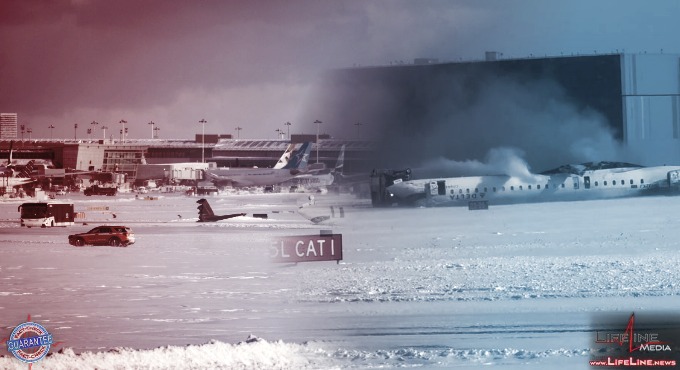Crash-Landing at Toronto Pearson Airport On February 17, 2025, Chaos Erupted at Toronto Pearson ...

FACT-CHECK GUARANTEE
Political Tilt
& Emotional Tone
The article maintains a neutral tone, focusing on factual reporting without any discernible political agenda.
Generated using artificial intelligence.
The emotional tone is slightly positive, highlighting the successful evacuation and response efforts amid a serious incident.
Generated using artificial intelligence.
Updated:
Read
On February 17, 2025, chaos erupted at Toronto Pearson International Airport as Delta Flight 4819, a Bombardier CRJ-900, faced a perilous situation. Originating from Minneapolis, the aircraft encountered fierce winds and swirling snow during its approach, leading to a dramatic crash-landing. At approximately 2:15 PM local time, the plane flipped onto its roof, injuring 18 individuals. Miraculously, there were no fatalities.
Passengers described the ordeal as unnerving, with some recalling the landing as “sideways” and “upside down.” Despite the chaos inside the cabin, all 71 passengers and crew members were evacuated safely, thanks to the rapid response of emergency services. Fire Chief Todd Aitken praised the first responders for their swift and effective actions. Eyewitness footage captured the surreal scene of bewildered passengers emerging from the overturned plane.
Response and Investigation
The airport activated its emergency protocols immediately in response to the incident. Delta personnel collaborated with local emergency services to manage the situation efficiently. Toronto Mayor Olivia Chow expressed relief that everyone was accounted for and unharmed beyond injuries. Meanwhile, Pearson International temporarily suspended all flights to ensure safety and facilitate a thorough investigation.
The Transportation Safety Board of Canada promptly initiated an inquiry into the crash. Early reports suggested no crosswinds during landing and confirmed that the runway surface was dry. Most injuries were minor, though eight individuals required further medical attention at nearby hospitals. Delta Airlines CEO Ed Bastian expressed concern and empathy for those affected, reiterating the airline’s commitment to passenger safety. In light of the incident, Delta extended travel waivers to those impacted.
This alarming event underscores the inherent risks of air travel amidst severe weather conditions. Despite advancements in aviation safety measures and sophisticated aircraft technology, unpredictable weather continues to pose challenges worldwide. However, the resilience exhibited by both passengers and crew is a testament to the efficacy of modern safety protocols.
As investigations proceed, updates from both Delta Airlines and the Transportation Safety Board are keenly awaited. This comprehensive review aims to uncover preventive strategies that could avert similar occurrences in the future. By fortifying safety measures against adverse weather phenomena, airlines strive to safeguard travelers globally.
In this high-stakes environment where nature’s whims can disrupt even the best-laid plans, it remains crucial for aviation authorities and airlines alike to continuously adapt and enhance their safety frameworks. The lessons learned from this incident will be pivotal in shaping more robust responses to ensure passenger safety remains paramount amidst nature’s unpredictability.
Airlines worldwide are reminded of the importance of rigorous training for both pilots and crew members in handling emergency situations. Continuous investment in technology and infrastructure can help mitigate risks associated with severe weather conditions. By fostering a culture of safety and preparedness, airlines can better protect their passengers and crew against unforeseen events.
Ultimately, this incident serves as a stark reminder of the challenges faced by the aviation industry. It highlights the need for ongoing vigilance and improvement in safety protocols to ensure that air travel remains one of the safest modes of transportation. As investigations continue, the industry is poised to learn valuable lessons that will enhance safety measures and bolster confidence in air travel worldwide.

I started earning $85/hour in my free time by completing tasks with my laptop that i got from this company I stumbled upon online…Check it out, and start earning yourself . I can say my life is improved completely! Take a gander at it what I do….. For more detail visit the given link↠↠↠☛ Www.HighProfit1.Com
as